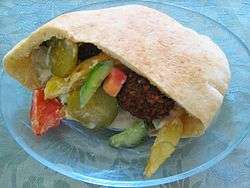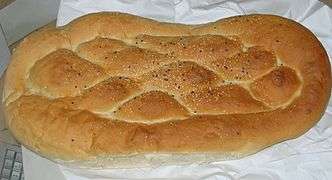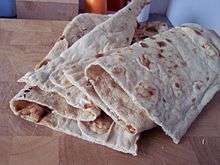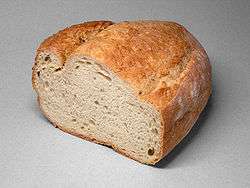Pita
 | |
| Place of origin | Middle East |
|---|---|
| Main ingredients | Flour, water, yeast, salt |
|
| |
- In many languages, the word 'pita' refers not to flatbread, but to flaky pastries; see börek.
Pita or pitta (/ˈpɪtə/ or US /ˈpiːtə/)[1] also known as Arabic bread, Lebanese bread or Syrian bread,[2][3][4] is a soft, slightly leavened flatbread baked from wheat flour, which originated in the Near East,[4][5] most probably Mesopotamia around 2500 BC.[6] It is used in many Mediterranean, Balkan and Middle Eastern cuisines and resembles other slightly leavened flatbreads such as Iranian nan-e barbari, Central and South Asian flatbreads (such as naan), and pizza crust.
Etymology
Pita is a Modern Hebrew word (pittāh פיתה), originating from the Classical Hebrew word patt פת (literally "a morsel of bread"). It is spelled like the Aramaic pittəṭā/pittā (פיתה), from which it was received into Byzantine Greek (see below) and later into Levantine Arabic (as fatteh since Arabic lacks the sound /p/).[7] In Arabic, it is commonly called "خبز" (khubz, bread).
The first known mention of the word in English was in 1936.[7] The English word is borrowed from Modern Greek πίτα. These all probably come from the Byzantine Greek πίτα 'bread, cake, pie, pitta' (attested in 1108).[7] Some sources trace it to the Ancient Greek πίττα or πίσσα 'pitch/resin',[8][9] while others characterize this as "unlikely" and trace it to Latin picta 'painted', itself supposedly from Greek πηκτή 'congealed'.[10][11] Other hypotheses trace it to Germanic[12] or Illyrian.[13]
The word has been borrowed by Turkish as pide,[14] and appears in the Balkan languages as Serbo-Croatian pita, Romanian pită, Albanian pite, Bulgarian pitka or pita. In Arabic, the phrase "خبز البيتا" (pita bread) is sometimes used; other names are simply "خبز" 'bread' or "الخبز العربي" 'Arab bread' or "خبز الكماج" 'al-kimaj bread'.[15] In Egypt, it is called ʿaish (عيش) or ʿaish baladi (عيش بلدي).[16]
Preparation
Most pita are baked at high temperatures (450 °F or 232 °C), causing the flattened rounds of dough to puff up dramatically. When removed from the oven, the layers of baked dough remain separated inside the deflated pita, which allows the bread to be opened to form a pocket. However, pita is sometimes baked without pockets and is called "pocket-less pita".
Nowadays, modern commercial pita bread is prepared on advanced automatic lines. These lines have high production capacities, up to thousands per hour.
Culinary use
Pita can be used to scoop sauces or dips such as hummus and taramosalata, or to wrap kebabs, gyros or falafel in the manner of sandwiches. It can also be cut and baked into crispy pita chips.
In Greece, pita is a component of pita-souvlaki. These types of sandwiches involve the wrapping of souvlaki or gyros with tzatziki, tomatoes, onions, french fries, and condiments into a pita bread. Pita is also the name of a type of pastry found throughout Greece, filled with a variety of ingredients. Some examples of these pies are Kolokythopita (filled with pumpkin), Mizithropita (mizithra cheese filling - a specialty of Crete), Melintzanopita (eggplant filling), Tsouknidopita (stinging nettle filling), Kremydopita (onion filling), Kreatopita (meat pie), Galatopita (custard filling), Marathopita (fennel filling), Tyropita (egg and cheese filling), Spanakopita (spinach and feta filling), and Ladopita (semolina pie).
In Cyprus, pita is typically rounder, fluffier and baked on a cast iron skillet. Used for souvlakia, sheftalia, halloumi with lountza, and gyros.
In Egyptian, Jordanian, Iraqi, Israeli, Lebanese, Palestinian, and Syrian cuisine, almost every savory dish can be eaten in or on a pita. Common fillings include falafel, lamb or chicken shawarma, kebab, omelettes such as shakshouka (eggs and tomatoes), hummus and other mezes.
In Turkish cuisine, the word pide may refer to three different styles of bread: a flatbread similar to that eaten in Greece and Arab countries, a pizza-like dish where the filling is placed on the (often boat-shaped) dough before baking, and Ramazan pide. The first type of pide is used to wrap various styles of kebab, while the second is topped with cheese, ground meat or other fresh or cured meats, and/or vegetables. Regional variations in the shape, baking technique, and toppings create distinctive styles for each region.
 A baker preparing "pide" in Istanbul.
A baker preparing "pide" in Istanbul. Puffed up, freshly baked pita bread on a conveyor belt.
Puffed up, freshly baked pita bread on a conveyor belt. Pita stuffed with falafel and salad.
Pita stuffed with falafel and salad. Ramazan pide
Ramazan pide.jpg) Pita with avocado, cucumber and pepper
Pita with avocado, cucumber and pepper
See also
- Khachapuri, a Georgian breaded cheese dish
- Khubz
- Matnakash, an Armenian bread related to the Ramadan pita
- Naan, a similar bread from India and Pakistan
- Pită de Pecica, an unrelated type of bread from Romania
- Rghaif
- Tandyr nan, a similar bread from Central Asia
References
- ↑ "pita". Cambridge English Pronouncing Dictionary (18th ed.). Cambridge University Press. 2011.
- ↑ Clifford A. Wright (2003). Little Foods of the Mediterranean: 500 Fabulous Recipes for Antipasti, Tapas, Hors D'Oeuvre, Meze, and More. p. 61.
- ↑ Sergio O. Serna-Saldivar (2012). Cereal Grains: Laboratory Reference and Procedures Manual. p. 215.
- 1 2 Jean E. Stewart, Junko Alice Tamakl, United States. Dept. of Agriculture. Nutrition Monitoring Division (1992). Composition of foods: baked products : raw, processed, prepared. 8. p. 6.
Pita bread originated in the Middle East and is also known as Arabic, Syrian, and pocket bread.
- ↑ Michael G. Elasmar (2014). The Impact of International Television: A Paradigm Shift. p. 188.
- ↑ Parsons School of Design (1973). Parsons bread book. p. 25.
The history of Pita Bread dates back about five thousand years. Its origin is Mesopotamia.
- 1 2 3 Oxford English Dictionary, Third Edition, 2006
- ↑ Aristotle University of Thessaloniki, Λεξικό της κοινής Νεοελληνικής
- ↑ for the gloss: Liddell, Scott, Jones A Greek–English Lexicon
- ↑ Babiniotis dictionary
- ↑ The connection between picta and πηκτή is not supported by the OED s.v. 'picture' nor by Carl Darling Buck, A Dictionary of Selected Synonyms in the Principal Indo-European Languages, 1949, 9.85 'paint', p. 629
- ↑ G. Princi Braccini, Archivio Glottologico Italiano 64:42-89 (1979), cited by the OED
- ↑ J. Kramer, Balkan-Archiv 14-15:220-231 (1990), cited by the OED
- ↑ Linda Civitello (2007). Cuisine and culture: a history of food and people (Paperback ed.). Wiley. p. 98. ISBN 0471741728.
- ↑ Cauvain, Stanley (2015). Technology of Breadmaking. New York: Springer. p. 232. ISBN 978-3-319-14687-4.
- ↑ Bard, Kathryn A. (2005). Encyclopedia of the Archaeology of Ancient Egypt. London: Routledge. p. 178. ISBN 978-1-134-66525-9.
External links
| Look up pita in Wiktionary, the free dictionary. |
| Wikibooks Cookbook has a recipe/module on |


